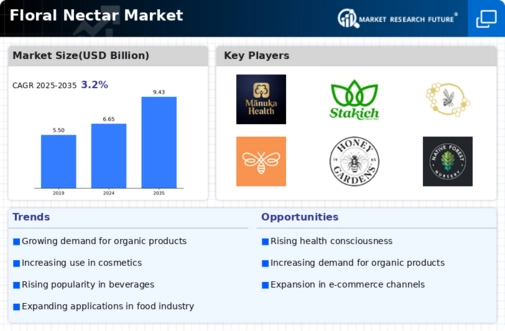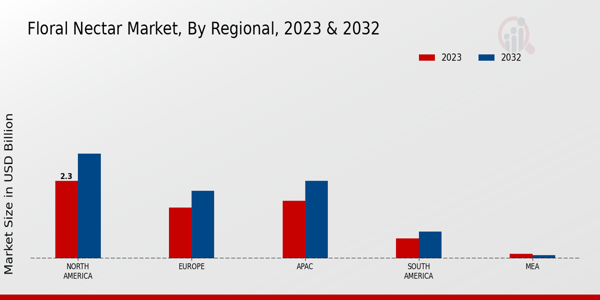Market Growth Projections
Rising Demand for Natural Sweeteners
The Global Floral Nectar Market Industry experiences a notable increase in demand for natural sweeteners as consumers become more health-conscious. This shift towards natural alternatives to refined sugars is driven by a growing awareness of the adverse health effects associated with excessive sugar consumption. Floral nectar, being a natural product, aligns with this trend, offering a healthier option for sweetening foods and beverages. In 2024, the market is projected to reach 6.65 USD Billion, reflecting the increasing preference for organic and natural ingredients in the food sector. This trend is likely to continue, as consumers increasingly seek products that are both nutritious and environmentally sustainable.
Health Benefits and Nutritional Value
The Global Floral Nectar Market Industry benefits from the increasing recognition of the health benefits and nutritional value of floral nectar. Rich in vitamins, minerals, and antioxidants, floral nectar is perceived as a functional food that can enhance overall well-being. This perception is supported by ongoing research that suggests potential health benefits, such as improved digestion and immune support. As consumers become more informed about the nutritional advantages of floral nectar, its popularity is likely to rise. This trend may contribute to the projected compound annual growth rate (CAGR) of 3.23% from 2025 to 2035, as more consumers opt for products that offer health benefits alongside taste.
Growing Interest in Sustainable Products
The Global Floral Nectar Market Industry is increasingly shaped by the growing interest in sustainable and environmentally friendly products. Consumers are becoming more aware of the ecological impact of their purchasing decisions, leading to a preference for products that are sourced sustainably. Floral nectar, often produced through sustainable practices, appeals to this demographic. This trend is further supported by initiatives aimed at promoting biodiversity and supporting local ecosystems. As sustainability becomes a key factor in consumer choices, the demand for floral nectar is expected to rise, potentially influencing market dynamics and encouraging producers to adopt more sustainable practices.
Expansion of the Food and Beverage Sector
The Global Floral Nectar Market Industry is significantly influenced by the expansion of the food and beverage sector. As the industry grows, there is a corresponding rise in the incorporation of floral nectar into various products, including beverages, desserts, and health foods. This integration is driven by the unique flavor profiles and potential health benefits associated with floral nectar. The market is expected to grow to 9.43 USD Billion by 2035, indicating a robust demand for floral nectar as an ingredient. Furthermore, the increasing trend of artisanal and craft food production is likely to enhance the market's growth, as manufacturers seek to differentiate their products through unique and natural ingredients.
Innovations in Packaging and Product Development
The Global Floral Nectar Market Industry is witnessing innovations in packaging and product development, which play a crucial role in attracting consumers. Manufacturers are increasingly focusing on creating appealing and functional packaging that enhances the consumer experience. Additionally, product development efforts are aimed at introducing new floral nectar varieties and blends, catering to diverse consumer preferences. This innovation not only helps in differentiating products in a competitive market but also aligns with consumer trends towards convenience and quality. As these innovations continue to evolve, they are likely to contribute to the overall growth of the market, fostering increased consumer engagement.














